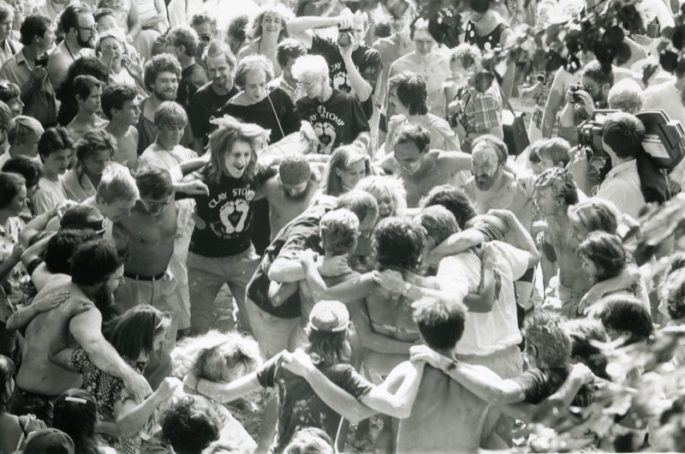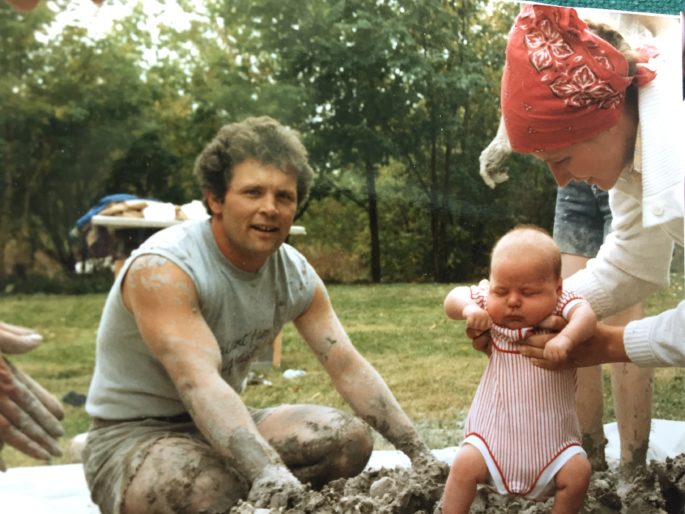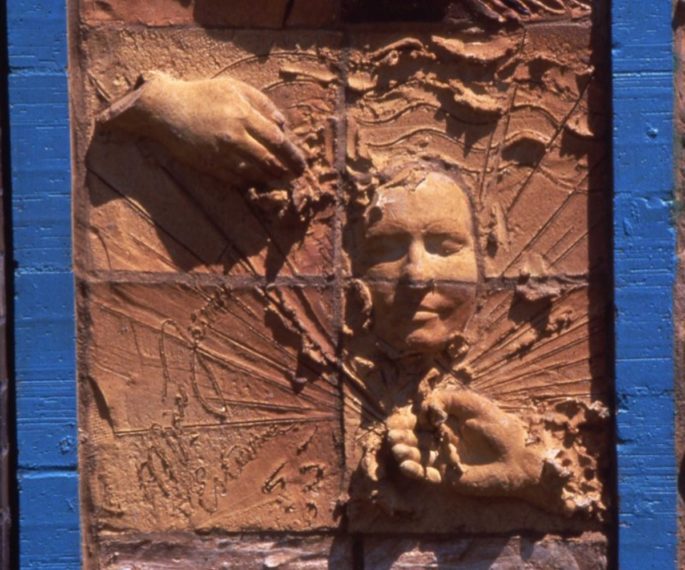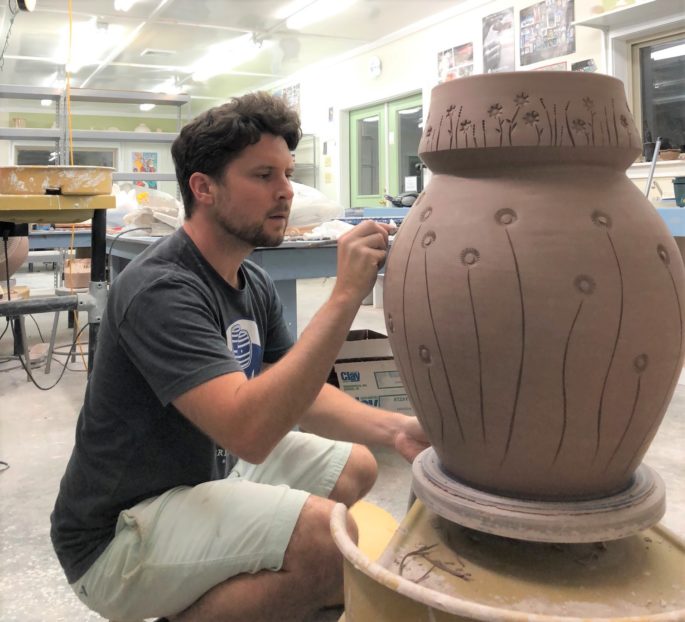Posted 4 p.m. Friday, Aug. 9, 2019

What started in one alum’s backyard became a worldwide way to share culture, strengthen community, create art.
The world has more massive murals, more global friendships and more gatherings with the goal of getting dirty — all because of one UWL alumnus.
Artist Joel Pfeiffer, ’72, has organized more than 100 Clay Stomps around the world, the vast majority at schools, art centers and libraries with the intention of creating a permanent work of art.
Clay stomps started in 1974 as a cost-effective way for Pfeiffer, an art teacher, to get clay for his art. Mixing the water and powdered clay by hand — or foot — was much cheaper than purchasing pre-mixed clay. But, over the years, Clay Stomps grew into more than a practical endeavor. Pfeiffer quotes a friend from a Clay Stomp he held in St. Petersburg, Russia, “As we mix the clay, the clay mixes us.”

This June was the 30th anniversary of the American-Soviet Clay Stomp. Documented by PBS, the stomp included more than 5,000 people mixing eight tons of clay in Milwaukee to create a ceramic mural depicting peace and friendship. Then, a group of 30 of those participants flew to Russia, mural in tow. There, several thousand Russians stomped six tons of clay, creating a ceramic mural for Milwaukee. Both murals were installed in fall 1990 — the Russian mural at the Mitchell International Airport in Milwaukee and the American Mural at the Port of St. Petersburg, Russia. While the end product of a Clay Stomp is a piece of art that lasts generations, the process of making it is just as significant.
“Clay Stomps transcend age and nationality,” explains Joel. “Everyone just blends together.”
Now, Joel's son, Jarred Pfeiffer, who starts as an assistant professor of ceramics at UWL in the fall, is continuing the tradition. With six stomps under his belt, he plans to bring them to UWL.
Finding footprints
Joel’s first encounter with clay came at UWL. A physical education major heading to class, he spotted dust footprints in hallway of Graff Main Hall. Curious, Joel followed them down the hall and through a set of double doors. Inside, in the back in the corner of the room, a student sat at a potter’s wheel with her hands gliding over spinning clay. Joel asked what she was working on and she explained she was creating planters for the dean’s office. Still curious, Joel asked if he could watch.
“She was taking this solid ball of clay and magically turning it into this incredible form right before my eyes,” he recalls. “Obviously, I must have been hypnotized. I skipped my next class.”
The next semester Joel signed up for a ceramics class. Physically touching the clay for the first time was all he needed to change his major from physical education to art. Clay opened new possibilities.
“I realized anything I can imagine, I can create,” he recalls.
Step 1: Mix
When Joel left UWL to begin his career as a full-time art teacher and part time artist in Howards Grove, Wisconsin, he needed art supplies – including expensive clay. He could save money by purchasing clay in powder form, adding water and mixing it himself. But mixing 700 lbs of clay would take a lot of time with just his own two feet, so he invited five neighbors to help. In his Sheboygan, Wisconsin, backyard, they stomped the clay and had some fun in the process. “It seemed to mix us pretty quickly,” he recalls.
As Joel needed more clay, he continued to bring people together to stomp. He held his first, large community Clay Stomp at Sheboygan Bratwurst Days — an event that was more about mixing community than mixing the clay. Subsequent Clay Stomps culminated with participants creating a lasting piece of collaborative art work with the clay, often a mural.
Joel organized the first international Clay Stomp in 1993 at Northern Arizona University in Flagstaff, with participants from 37 countries. In a time before such activities were announced and shared on the Internet, he worked with legislators, Rotary International and the National Ceramics Organization to send invitations to artists and musicians worldwide. The event attracted thousands and was covered by the Chicago Tribune.
"The goal of this whole project is world peace," says Joel in the March 1993 story. "I know that's a lofty thought, but it all starts with one step, or one stomp."
Step 2: Start stomping
Early in his career, Joel was holding so many Clay Stomps, that it was only natural that his children were participants too. Jarred’s first step into a stomp was documented in a photo at four weeks old.
Jarred remembers how clay was an integral part of his early life. He has fond memories of molding alien-looking creatures from clay with his friend. Once fired, they lit fires in their mouths and watched the smoke seep out of their eyes. They called them “Crawling Ear Infections,” he recalls with a laugh.

As an undergraduate student at UW-Madison, Jarred took ceramics classes as a respite from math and science courses. And, like his father, working with clay got him hooked. It was something he could envision doing the rest of his life. He ultimately changed his major from engineering to art and continued to study fine arts in graduate school at Kansas State University. That’s where he held his first clay stomp, followed by five more at his first position out of graduate school as head of ceramics at Cuesta College in San Luis Obispo, California.
“It is a legacy,” Jarred says of the stomps. “It is not often that you have a father so passionate about something, and it just so happens that the son is just as passionate.”
He calls clay stomps “amazing” events that bring communities together.
Step 3: Inspire with your art
Joel recalls a Clay Stomp he held about a decade ago at an elementary school in Madison. He walked inside the school after a morning outside mixing 10 tons of clay with kids in a parking lot. Tired, with clay covering him head to toe, he entered through the double doors of the school. There on the floor ahead of him were dust footprints from kids’ shoes tracking down the hall.
“That was the first time that it hit me — what following those footprints led to,” he says, recalling his first UWL encounter with clay.

In fact, the tracks in Graff Main Hall have led all the way back to UWL. Joel is so excited to see Jarred find a career in ceramics at his alma mater.
Jarred says the position is exactly what he was looking for.
“The opportunity to work with university students and moving closer to family in a place I love has always been incredibly appealing to me,” he says.

Joel recently opened a new fund through the UWL Foundation to support UWL’s Ceramics Department. Joel says he wanted to support ceramics and his alma mater.
“It is my way of giving back to the school that sparked my whole life in the arts and ultimately all my kids being connected through the arts,” he says.
The term “Clay Stomp” is Joel Pfeiffer’s registered trademark. He wanted to protect the event he created and the community-based artwork it stands for.
